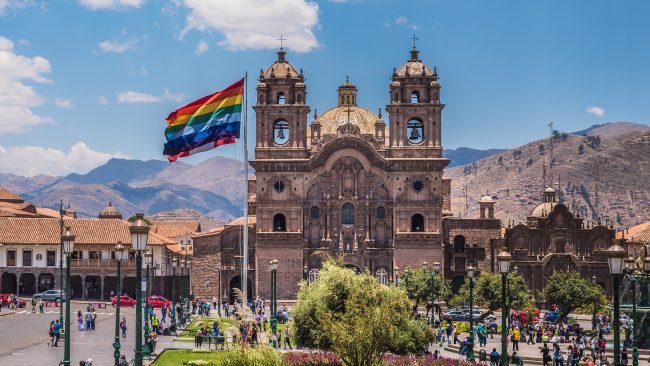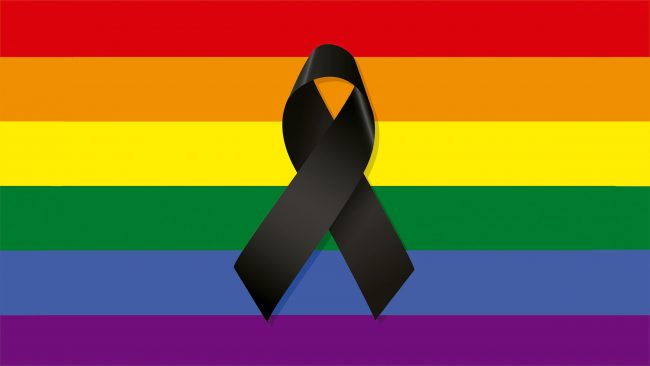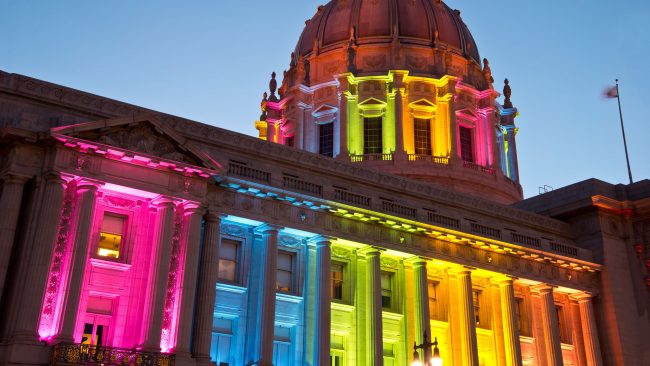The gay pride, LGBT, rainbow or freedom flag is the main gay insignia today. Its meaning is related to diversity and respect for the rights of homosexuals. In what follows, we explain why it has so many colors and what its origins are.
Below you have an index with all the points that we are going to deal with in this article.
Article Index
- 1.
- 2.
- 3.
- 4.
Why is it the colors of the rainbow?
Originally, the LGBT pride flag consisted of eight stripes, including the colors pink and turquoise. While the former symbolized sexuality, turquoise was related to magic and art.
To this day, it continues to be used as a symbol of homosexual and lesbian pride. Its meaning is associated with each of the colors that compose it, which are reproduced in the same order as the colors of the rainbow:
- RED: lifetime
- Orange: Health
- Yellow: sunlight
- Verde: nature
- BLUE: serenity
- Purple: spirit
The fact that it has so many colors is explained because the objective is to represent the diversity within the LGBT community, which includes lesbians, gays, bisexuals and transsexuals. It is an international symbol and a sign of tolerance and respect towards these people.
It imitates the chromatic range of the rainbow as a way to vindicate the rights of homosexuals and the diversity of genders. It is similar to other flags, such as that of cooperativism, in which seven colors appear representing universal peace.
It is also distinguished from the flag of peace because the colors appear inverted. Thus, while in the gay emblem the first band is red, in that of peace the first color is purple. This was done precisely to prevent them from being confused.
It also bears similarity to the Inca or Cuzco flag, emblem of Tahuantinsuyo, that is, the Inca Empire. Both differ because in that of the Incas seven colors appear instead of six. They symbolize the seven chakras or energy centers of the human body.
Other LGBT symbols
In addition to the rainbow flag, there are other alternative symbols and emblems to designate each of the groups that make up the LGBT community as a whole. There are them to represent transsexuals, bisexuals, lesbians, queergender...
El lesbian and feminist movement is represented with a double-bladed ax called labrys. It was the symbol of the ancient Minoan civilization and is represented in various legends of Ancient Greece, including those related to the goddesses Demeter and Artemis.
Bisexuality is represented by bisexual triangles, created by Liz Nania in 1978. Two colors appear in the bisexual pride triangle: pink and blue. Thus, the pink represents homosexuality and the blue heterosexuality.
The osuna brotherhood o bear brotherhood refers to the group of gay men called "bears", characterized by their robust physique and abundant body and facial hair. Bear homosexuals flee from the stereotype of the effeminate homosexual.
Transgender people (transvestites and transsexuals) are represented by a modification of the typical symbol of the sexes, in such a way that both masculine and feminine concepts are incorporated in the same image.
The flag of transgender pride It consists of five horizontal bands in sky blue, pink and white. According to the author, Monica Helms, these are the traditional colors to dress boys and girls mixed with white, representing those who are in transition.
La intersexuality, biological phenomenon in which the individual has characteristics of man and woman, also has its own symbol. Previously, the term "hermaphrodite" was used, but it is being replaced as it is confusing and insensitive to members of this group.
What is its history?
It was created by Gilbert Baker in 1978 and included two more stripes: one pink and one turquoise. Although it became famous as an international symbol of unity between people, little by little its colors became related to gay pride. Its author died on March 30, 2017 in New York.
Before it began to be used, the symbol of the pink triangle was simply used, but it fell into disuse due to its relationship with Nazism, since it was sewn on the clothes of homosexuals during this time to differentiate them from heterosexuals.
Baker thought of eight colored lines keeping in mind the design of the symbol that represented various social organizations in San Francisco, California. Its use in gay pride parades began to become popular after the murder of George Moscone and Harvey Milk in 1978, both gay rights activists.
It has gone through several stages since 1978 and its design has been modified several times until it is as it is now, that is, with six horizontal stripes representing the color range of the rainbow. Until 1978, it consisted of seven stripes, until the turquoise color was removed from it.
Although it was invented in the United States, today it is used worldwide to represent the LGBT community. Currently, the world's largest gay flag it flies in the Nelson Mandela Bay of Port Elizabeth (South Africa), 12 meters long by 8 meters high.
Recently, we have been able to see it at half mast or with the symbol of mourning in commemoration of the gays murdered in Orlando (Florida) in 2016. The massacre took place in one of the most popular gay clubs in the area and culminated in the deaths of 50 people.
Social networks as popular as Facebook, Twitter o Tumblr have contributed to the dissemination of rainbow colors during the campaigns for the celebration of the International LGBT Pride Day, which takes place every June 28. Google also used it as a doodle in 2014 to commemorate the Sochi Olympics, Russia.
At Eurovision festival, the LGBT movement has been getting noticed in recent years, especially by the Russian audience. Also the transgender collective, thanks to Conchita Wurst, winner of the festival on behalf of Austria in 2014.
It is even the official flag of the Gay and Lesbian Kingdom of the Coral Sea Islands, a micronation located in Australia which, despite not being recognized by any country, proclaimed itself a state in 2004 to protest against the prohibition of homosexual marriage in Australia.
Its popularity is such that there are those who buy it or make it at home for use in various contexts. There are also those who dress in multicolored clothes, paint their nails or even dye their hair in the colors of the rainbow to participate in gay pride marches.
Gay flag on big monuments
The homosexual flag has been used in recent decades to illuminate some of the most important buildings or monuments of great world capitals with its colors. It is usually done to celebrate the gay pride festival in order to claim acceptance by this community.
La Brandenburg Gate It is one of the world monuments that have been illuminated with the colors of the rainbow during the pride march. It should be remembered that Germany is one of the most gay-friendly countries in the world, where gay pride is celebrated in style, especially in Berlin.
El Town Hall of Madrid It's a good example. There, each year a large banner is displayed that reaches from the main balcony to the front door. It is the meeting point for the thousands of attendees who congregate there year after year.
Another of the most important cities for the LGBT community, both for living and for tourism, is Tel Aviv (Israel). The city has established itself in recent years as one of the main world capitals for its massive Gay Pride march, in which 200.000 people gather each year.
Today, Israel has become a leading country in terms of LGBT rights. In fact, except for Jordan, Israel is the only place gay-friendly from the Middle East, with wide acceptance by the Israeli government and society towards the gay community.
El san francisco city hall, probably the most important gay destination in the world, has also been illuminated with the colors of the rainbow flag during the celebration of the pride festival, which today lasts two days (Saturday and Sunday).
The American Embassy of Madrid It is another of the government buildings where the colors of the rainbow have been seen as a way to commemorate the approval of the law on homosexual marriage in Spain.
Another building in which it has been possible to see the gay flag in motion is the mayor of Bucaramanga, a municipality located in Colombia. In recent years, Colombia has become another of the booming gay destinations in South America, with numerous options for tourists in terms of fun and relaxation.
La Presidential House of Costa Rica, the seat of the Costa Rican government, is another of the buildings where the gay flag has been raised to celebrate the World Day Against Homophobia in the country, one of the most permissive and tolerant in Central America.
This article has been shared 72 times. We have spent many hours collecting this information. If you liked it, share it, please:





































